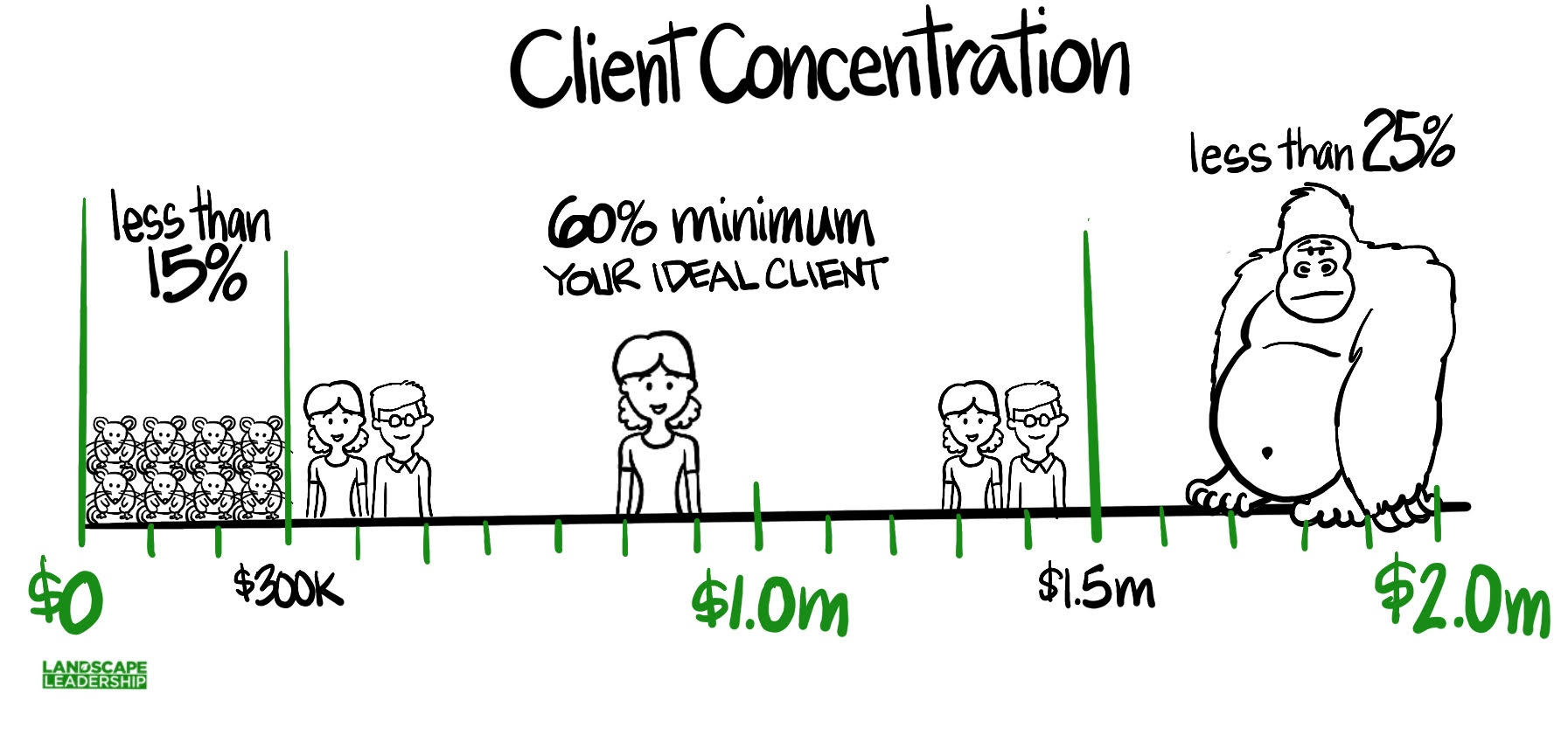Topics: Branding And Positioning Growth
Client Concentration Problems (or, How to Know When Clients are Too Big or Too Small)
 Author: Chris Heiler
Author: Chris Heiler
Have you ever won a large landscape maintenance bid, or landed a huge design/build project, and your immediate thought was, “Oh shit…”?
“Oh shit… did I estimate this accurately?”
“Oh shit… now we have to hire more people.”
“Oh shit… how will we fit this in our production schedule?”
I know the feeling. When I operated my landscape design firm years ago I loved selling the “big idea” (and collecting the deposit check) but dreaded what came after. That’s when all the second-guessing began.
With this in mind – and assuming I’m not the only landscape professional to have felt this way – I want to discuss the subject of “client concentration” and offer a practical framework which I think can keep many of you from potential and unnecessary financial stress. And, maybe more importantly, personal stress.
What is client concentration?
Client concentration is a measure of how total revenue is distributed among your client base.
A company serving a large number of small-volume customers (ex.- lawn care operator) has a lower customer concentration than a firm where a handful of large clients account for the majority of its business (ex.- landscape design/build firm).1
How do you know if your client concentration is high or low? A rule of thumb holds that if any single client accounts for ten percent or more of your revenue or if your largest five clients account for 25% or more of revenue, you have a high client concentration.2
There are problems and risks associated with both high and low concentrations.
Client concentration problems
I consider there to be a potential client concentration problem when one or two clients represent 25% or more of your company's revenue. You've probably heard these clients referred to as "gorilla clients" or "whales".
Setting aside the gorilla client for a moment, you can also have a client concentration problem when you serve too many low-revenue customers. Problems arise, in my estimation, when more than 15% of your revenue is represented by this group.
I'll use two of our clients as examples to illustrate this. The first example is a $3.0m landscape design/build company who takes on projects in the $50k to $200k range. If we take away the small maintenance work and enhancements they do for past clients, they really only build 15 to 20 new projects each year. We can say they have a high client concentration.
Recently, this company lost a $500,000 design/build project due to the coronavirus pandemic. We could argue this was a gorilla client, representing 1/6 of the company's total revenue for the year. That's a big hit.
Our second example is a company who focuses on residential lawn care and landscape maintenance. When we started working together a couple of years ago they had thousands of customers, but a large percentage of them (I believe over 20%) only paid for bi-weekly mowing rather than the more profitable lawn fertilization programs and landscape maintenance visits. This company also had a client concentration problem.
Client concentration risks
I'm not gonna pound my keyboard and tell you not to go after the gorilla clients. But you do need to thoughtfully weigh the reward with the risks. And there are many:
- What if the project isn't profitable because it wasn't estimated properly, or due to scheduling conflicts and delays? This could be a design/build installation or a large commercial maintenance account. Either way, a huge chunk of your revenue has proven to be unprofitable.
- If you have a habit of over-servicing and underpricing then a gorilla client can carry a death wish as you pour resources into it.
- Gorilla clients can be ultra-demanding. They know they are the gorilla in the room and just need to pound the table to get what they want. This distracts you from your other clients.
- When you lose your gorilla client, you lose the income before the expenses disappear. Remember how you had to purchase new equipment and hire more people to feed the gorilla? You're still paying for that.
- You can become complacent when relying on a gorilla client. This distracts you from new business development which should be your priority.
- It's frickin' stressful trying to appease a big-ass gorilla!
There are risks on the other side as well when you have too large a percentage of small clients:
- Again, frickin' stressful. Consider our client I mentioned above. Would you want to manage hundreds of customers who are only paying you to mow their lawns every other week? Sounds like a customer service nightmare.
- Expectations can be difficult to manage. In some instances these folks are even louder than the gorilla client and need more hand holding.
- You'll most likely have profitability issues because you're not making much on each individual small customer, yet they are a large percentage of your customer base.
I'm sweating as I write this because I've experienced all of these first hand. Ugh...
Sooo... what do you do?
Let's talk about how to protect yourself against these risks you face from both sides of the client concentration spectrum.
First off, you need to understand who your ideal client is currently. Not necessarily who you think it should be. Perhaps your ideal (i.e.- profitable) is residential design/build projects in the $25,000 to $75,000 range.
Look at the illustration I've shared below (based on a $2.0m company). This is my recommendation. Manage to this and you'll be able to minimize risk. But you'll need to run the numbers for yourself (and do this regularly).

Practically speaking, you'll need to do these things:
- Continue focusing your new business development efforts on attracting your ideal clients (not the gorilla or mice).
- Raise your prices and increase your minimum level of engagement (MLOE). As an example from earlier, stop offering bi-weekly mowing and instead insist on weekly mowing (and raise your price for it). Sure, you'll lose some customers. That's the point.
- Get used to saying "no" way more often. You don't have to accept every opportunity that comes your way. That goes for clients big and small.
I hope this illustration and framework helps. As you can see, I'm not suggesting that you shouldn't have a handful of smaller clients and one or two big ones. Just understand the balance that you need to achieve based on your company's revenue. Then manage to that ideal you set.
Do you want more insight like this? Subscribe to our blog and podcast like over 4,000 other lawn and landscape professionals are. We'll send new content straight to your inbox. Just add your email in the form below.
References:
1., 2.- Avoiding High Customer Concentration, Mark J. Marin for Gateway Commercial Finance




